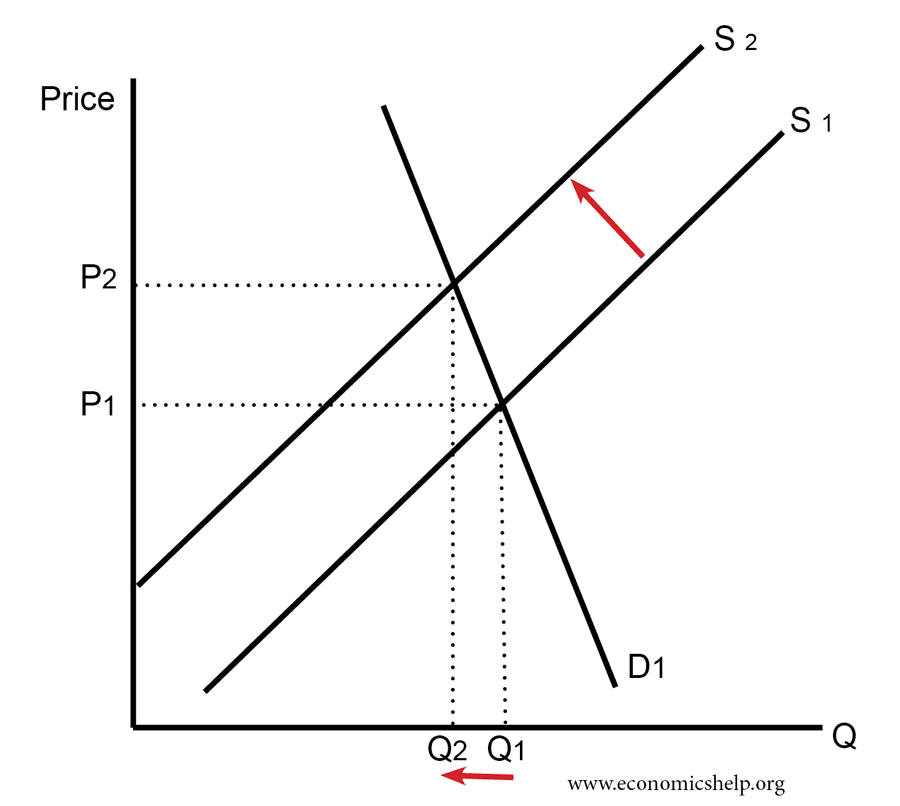Smoking causes an increased risk of cancer to both those who smoke and also to third party’s who breathe in other people’s smoke. It is a classic example of a demerit good.
To reduce smoking rates, the government can choose policies from
- Higher tax
- Raising legal minimum age
- Restrictions on smoking in public places
- Subsidies for treatment and support to stop smoking
- Advertising campaigns on health dangers
- Behavioural economics, such as nudges/choice architecture (e.g.availability of cigarettes for sale.)
Tax
In the UK and other western economies, the government’s use tax to increase the price of cigarettes and reduce demand.

One factor that reduces the effectiveness of tax is that demand for cigarettes is price inelastic – if people are addicted, they are willing to pay a higher price so in the short-term this policy is of limited effect.
The price of cigarettes in the UK

The prolonged increase in tax has had an effect on the long-term of reducing cigarette demand.

Evaluation of tax for reducing smoking
- In the short-term demand is inelastic, but over time, demand is more elastic
- Tax evasion. A disadvantage of high tax is that it can encourage evasion. The high tax compared to European rivals creates an incentive for people to buy cigarettes on the black market. For example, cigarettes smuggled from the continent can be up to 50% cheaper. This means that the government loses tax revenues and doesn’t succeed in reducing demand.
Raising the legal minimum age
Raising the legal minimum age discourages young people from starting to smoke. Some argue it could be raised to 21 to provide a further deterrent. Young people might start smoking when young because of peer pressure on the concept it appears ‘cool.’ Making it difficult to start might mean by the time they are older, the desire to start smoking is not there.
- Evaluation. A difficulty of a legal minimum age has always been the difficulty of enforcing it – with access to cigarettes relatively easy to come by. However, raising the age to 21, would definitely make it more difficult for 15 year olds to get away with buying.
Ban of smoking in public places
In 2007, smoking was banned in enclosed public places like pubs, restaurants and cafes. This has been a major deterrent to ‘social smoking’ Making it more difficult to enjoy smoking in a social setting. Smokers often found in the wrong environment it was easy to smoke more than usual.
The relative success of this policy has encouraged some campaigners to extend the policy and ban smoking – even in unenclosed spaces, e.g. outside cafes and pubs.
- This would probably have some impact on reducing demand, but campaigners argue it infringes civil right to enjoy smoking.
Nicotine replacement therapy
A difficulty of reducing smoking is the fact many smokers want to stop but nicotine is highly addictive. Treatments include nicotine patches and gums, which help to provide the nicotine hit whilst a smoker stops smoking. Funding for treatment for smokers to stop helps people to give up smoking.
Health and education campaigns
Over the past few decades, the government has introduced campaigns to warn about the health dangers of smoking and encourage people to stop smoking. In the short-term, there may be limited effect. But, the cumulative effect of health campaigns has influenced people’s attitudes to smoking and the health costs of smoking are now well known.
Behavioural economics to reduce smoking
An aspect of behavioural economics is concerned with influencing consumer behaviour. This can occur through nudges, choice architecture, advertising campaigns and the placement of cigarettes.
Choice architecture
At supermarket checkout tills, supermarkets often place sweets and chocolate to encourage ‘impulse’ buying. As we wait, our eyes are drawn to a treat and it can significantly increase sales. Conversely, the placing of cigarettes away from our eyes can make it an extra effort to ask to buy. If someone is determined to smoke, they will ask the cashier to get a packet from behind the screen. But, if someone is trying to give up smoking the extra effort may be just enough to discourage them from buying. Legislation has meant many shops are required to make it more difficult to buy cigarettes.
Nudge

This is not a particularly subtle nudge. The image may annoy smokers but makes smoking appear less attractive for non-smokers.
Related
